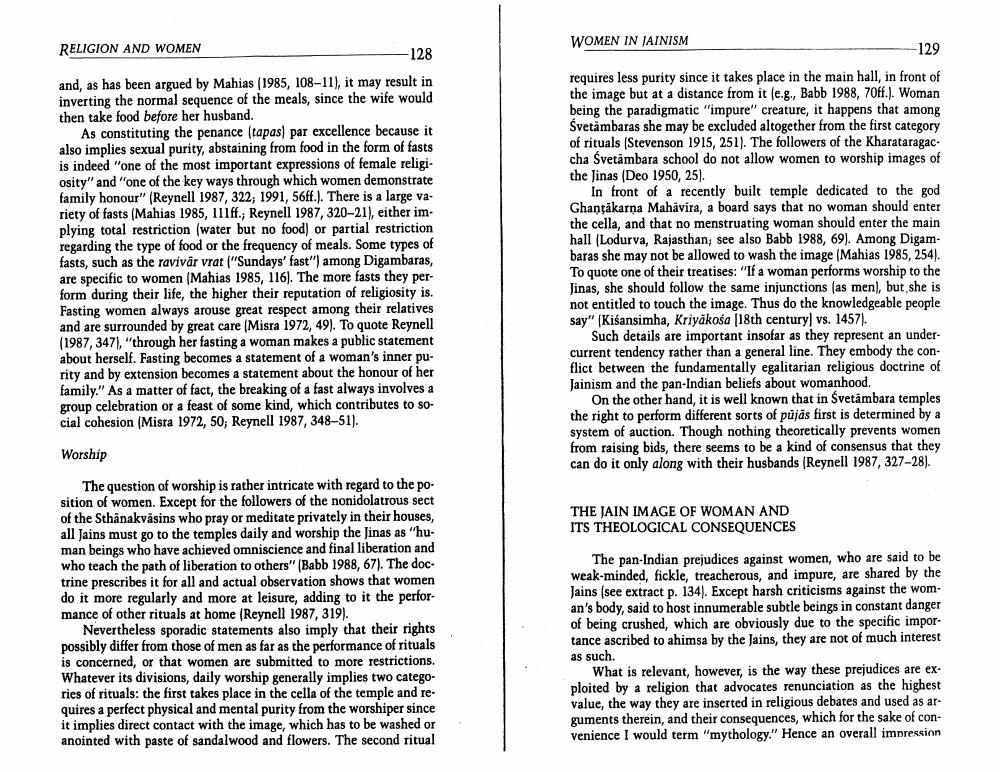Book Title: Women In Jainism Author(s): Nalini Balbir Publisher: Nalini Balbir View full book textPage 5
________________ RELIGION AND WOMEN -128 and, as has been argued by Mahias (1985, 108-11), it may result in inverting the normal sequence of the meals, since the wife would then take food before her husband. As constituting the penance (tapas) par excellence because it also implies sexual purity, abstaining from food in the form of fasts is indeed "one of the most important expressions of female religiosity" and "one of the key ways through which women demonstrate family honour" (Reynell 1987, 322; 1991, 56ff.). There is a large variety of fasts (Mahias 1985, 111ff.; Reynell 1987, 320-21), either implying total restriction (water but no food) or partial restriction regarding the type of food or the frequency of meals. Some types of fasts, such as the ravivar vrat ("Sundays' fast") among Digambaras, are specific to women (Mahias 1985, 116). The more fasts they perform during their life, the higher their reputation of religiosity is. Fasting women always arouse great respect among their relatives and are surrounded by great care (Misra 1972, 49). To quote Reynell (1987, 347), "through her fasting a woman makes a public statement about herself. Fasting becomes a statement of a woman's inner purity and by extension becomes a statement about the honour of her family." As a matter of fact, the breaking of a fast always involves a group celebration or a feast of some kind, which contributes to social cohesion (Misra 1972, 50, Reynell 1987, 348-51). Worship The question of worship is rather intricate with regard to the position of women. Except for the followers of the nonidolatrous sect of the Sthanakväsins who pray or meditate privately in their houses, all Jains must go to the temples daily and worship the Jinas as "human beings who have achieved omniscience and final liberation and who teach the path of liberation to others" (Babb 1988, 67). The doctrine prescribes it for all and actual observation shows that women do it more regularly and more at leisure, adding to it the performance of other rituals at home (Reynell 1987, 319). Nevertheless sporadic statements also imply that their rights possibly differ from those of men as far as the performance of rituals is concerned, or that women are submitted to more restrictions. Whatever its divisions, daily worship generally implies two categories of rituals: the first takes place in the cella of the temple and requires a perfect physical and mental purity from the worshiper since it implies direct contact with the image, which has to be washed or anointed with paste of sandalwood and flowers. The second ritual WOMEN IN JAINISM -129 requires less purity since it takes place in the main hall, in front of the image but at a distance from it (e.g., Babb 1988, 70ff.). Woman being the paradigmatic "impure" creature, it happens that among Śvetämbaras she may be excluded altogether from the first category of rituals (Stevenson 1915, 251). The followers of the Kharataragaccha Śvetambara school do not allow women to worship images of the Jinas (Deo 1950, 25). In front of a recently built temple dedicated to the god Ghantäkarna Mahävira, a board says that no woman should enter the cella, and that no menstruating woman should enter the main hall (Lodurva, Rajasthan; see also Babb 1988, 69). Among Digambaras she may not be allowed to wash the image (Mahias 1985, 254). To quote one of their treatises: "If a woman performs worship to the Jinas, she should follow the same injunctions (as men), but she is not entitled to touch the image. Thus do the knowledgeable people say" (Kiśansimha, Kriyakosa (18th century] vs. 1457). Such details are important insofar as they represent an undercurrent tendency rather than a general line. They embody the conflict between the fundamentally egalitarian religious doctrine of Jainism and the pan-Indian beliefs about womanhood. On the other hand, it is well known that in Svetämbara temples the right to perform different sorts of pujas first is determined by a system of auction. Though nothing theoretically prevents women from raising bids, there seems to be a kind of consensus that they can do it only along with their husbands (Reynell 1987, 327-28). THE JAIN IMAGE OF WOMAN AND ITS THEOLOGICAL CONSEQUENCES The pan-Indian prejudices against women, who are said to be weak-minded, fickle, treacherous, and impure, are shared by the Jains (see extract p. 134). Except harsh criticisms against the woman's body, said to host innumerable subtle beings in constant danger of being crushed, which are obviously due to the specific importance ascribed to ahimsa by the Jains, they are not of much interest as such. What is relevant, however, is the way these prejudices are exploited by a religion that advocates renunciation as the highest value, the way they are inserted in religious debates and used as arguments therein, and their consequences, which for the sake of convenience I would term "mythology." Hence an overall impressionPage Navigation
1 ... 3 4 5 6 7 8 9 10 11 12
